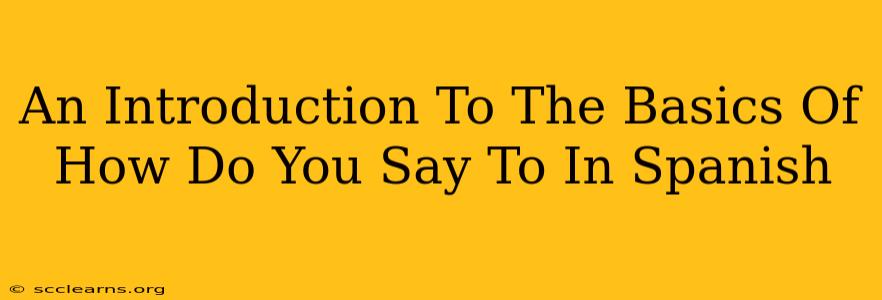Learning a new language can feel overwhelming, but mastering the little words—the prepositions, articles, and conjunctions—is key to fluency. Today, we'll tackle one of those crucial little words: how to say "to" in Spanish. It's not as simple as a one-to-one translation, as Spanish uses different words depending on the context. Let's break it down!
Understanding the Nuances of "To"
In English, "to" can function as a preposition, an infinitive marker, or even part of an infinitive phrase. Spanish, being a beautifully nuanced language, reflects this complexity with various options. We'll explore the most common ways to express the meaning of "to" in Spanish:
1. A (To Indicate Direction or Destination)
This is the most straightforward equivalent. Think of it as the "to" in sentences like "I'm going to the store."
- Example: Voy a la tienda. (I'm going to the store.)
- Example: Ella va a la playa. (She's going to the beach.)
Here, a indicates movement towards a place or destination. It's crucial to remember that a is a preposition, and it's essential to use the correct article (el, la, los, las) after it, depending on the gender and number of the noun.
2. Para (To Indicate Purpose or Recipient)
Para translates to "for" or "to" depending on the context. It signifies the purpose of an action or the recipient of something.
- Example: Este regalo es para ti. (This gift is for you/This gift is to you.)
- Example: Necesito un cuchillo para cortar el pan. (I need a knife to cut the bread.)
Notice how para clarifies the purpose (cutting bread) or the recipient (you).
3. Hasta (To Indicate "Until" or "As Far As")
Hasta translates to "until" or "as far as". It's important to distinguish it from a and para.
- Example: Voy hasta la esquina. (I'm going as far as the corner.)
- Example: Trabajaré hasta las cinco. (I will work until five o'clock.)
4. The Infinitive (To Express an Action)
In English, we often use "to" before a verb in its infinitive form (e.g., "to eat," "to sleep"). In Spanish, the infinitive is the base form of the verb, and it doesn't require a separate word like "to."
- Example: Quiero comer. (I want to eat.)
- Example: Necesito dormir. (I need to sleep.)
Mastering the "To" in Context
The best way to master these different uses of "to" in Spanish is through practice. Pay close attention to the context of each sentence to determine the most appropriate translation. Don't be afraid to experiment and make mistakes; it's all part of the learning process.
Expanding Your Spanish Vocabulary
Learning how to accurately say "to" in Spanish opens the door to more sophisticated conversations. Continue exploring other prepositions and grammatical structures to build a stronger command of the language. This is a crucial step in your Spanish language journey! Remember to practice regularly, and you'll be speaking fluently in no time.

